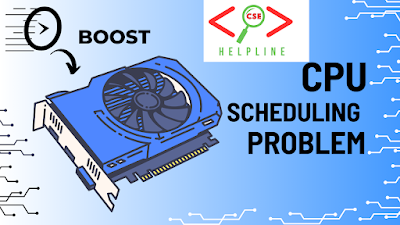The CPU scheduling problem is concerned with determining the order in which processes are executed by the CPU in a multi-programming environment. Several algorithms exist to solve this problem, each with different characteristics, advantages, and trade-offs depending on the system's goals (e.g., maximizing throughput, minimizing waiting time, etc.).
Here are the most common CPU scheduling algorithms and their approaches to problem-solving:
1. First-Come, First-Served (FCFS):
- Approach: The process that arrives first is executed first.
- Problem: It can cause the convoy effect, where shorter processes get stuck waiting behind longer ones.
- Solution: Simple to implement, but inefficient when dealing with processes of varying lengths.
2. Shortest Job Next (SJN) or Shortest Job First (SJF):
- Approach: The process with the shortest execution time is selected first.
- Problem: It requires knowledge of process execution times, which may not always be available. Can lead to starvation of longer processes.
- Solution: SJF can be modified into a preemptive version known as Shortest Remaining Time First (SRTF) to preempt long processes and execute shorter ones.
3. Round-Robin (RR):
- Approach: Processes are executed for a fixed time slice (quantum), and then the next process in the queue is given CPU time.
- Problem: If the time quantum is too short, excessive context switching can reduce CPU efficiency.
- Solution: Optimize the time quantum to balance responsiveness and context-switching overhead.
4. Priority Scheduling:
- Approach: Each process is assigned a priority, and the CPU is assigned to the process with the highest priority.
- Problem: Low-priority processes can suffer from starvation.
- Solution: Implement aging, where the priority of a process increases the longer it waits.
5. Multilevel Queue Scheduling:
- Approach: Processes are divided into different queues based on priority, and each queue has its own scheduling algorithm.
- Problem: Finding an optimal policy for moving processes between queues can be challenging.
- Solution: Predefined policies based on the types of processes in the system (e.g., interactive vs. batch).
6. Multilevel Feedback Queue Scheduling:
- Approach: Similar to multilevel queue scheduling, but allows processes to move between queues based on their behavior and CPU burst characteristics.
- Problem: Complex to implement and tune.
- Solution: A flexible approach that adapts to the needs of processes dynamically, but requires careful selection of parameters like time quantum and feedback policy.
Problem-Specific Considerations:
- Throughput vs. Turnaround Time: Maximizing the number of processes completed in a given time vs. minimizing the time taken to complete individual processes.
- Response Time: In interactive systems, it's important to reduce the time from when a request is submitted until the first response is produced.
- CPU Utilization: Keeping the CPU as busy as possible to improve overall system performance.
To solve specific CPU scheduling problems, you must understand the nature of the processes (interactive, batch, real-time), the system’s goals, and the constraints involved.

.jfif)

.png)
Comments
Post a Comment